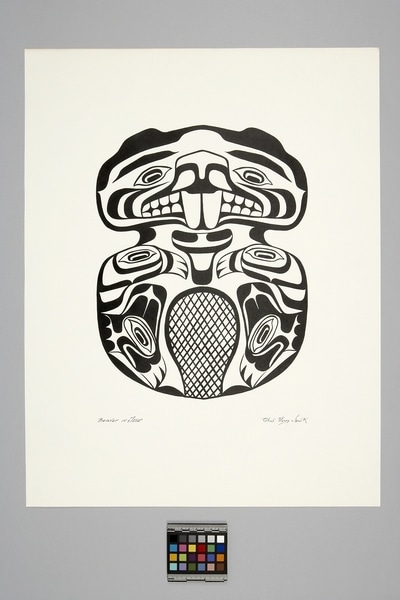Beaver, Tsow Item Number: Nb3.1403 from the MOA: University of British Columbia

Description
Silkscreen print of a beaver with a large head. Body of beaver is rounded in two parts. Frontal view is outlined in black. There is a slight rising on either side of the head above tje eyes to indicate ears. Thick, even black eyebrows with tapering ends, large wide nose, and two U-shaped incisors. Paws in front of the body with ovoid eyes on forelimbs holding a stick. Below the stick, there is a crosshatched inverted u form. The hind feet are raised up under forelimbs and both have black split u's, ovoid with eye, and three toes on each paw. Black inscription below image. The print is on vertically rectangular, off-white paper.
History Of Use
Northwest Coast print making is a relatively new art form, which began in the late 1940's, but did not develop until the late 1960's. The establishment of the Northwest Coast Indian Artists Guild, in 1977, aided the implementation of standards in limited addition runs and various aspects of quality control. Silk-screen prints have been used to portray traditional and contemporary themes, as well as to make personal statements. Kwakwaka'wakw artists have, in general, preferred to work with traditional crest designs and mythical themes. More colours are used by Kwakwaka'wakw artists than are used by northern Northwest Coast artists, and the images are composed of many small elements combining into relatively realistic forms.
Iconographic Meaning
Beaver is an important crest, the subject of many legends and found in many forms. Beaver is characterized by 2 large incisors, a rounded, wide, cross-hatched tail, ears and 2 front paws either holding a stick or held up in front; if frontal view the tail is up against the chest.
Cultural Context
contemporary art
Narrative
Nb3.1335 to Nb3.1343 were given to Audrey Hawthorn in 1973. This collection of Henry Speck prints is from an unnumbered collection printed in the 1960's.
Item History
- Made by Chief Henry Speck (Maker) in British Columbia, Canada during 1962
- Collected during 1973
- Owned by Audrey Hawthorn before June 21, 1976
- Received from Audrey Hawthorn (Donor) on June 21, 1976
What
- Name
- Beaver, Tsow
- Identification Number
- Nb3.1403
- Type of Item
- Manufacturing Technique
- silkscreened
- Overall
- height 62.4 cm, width 48.2 cm, depth 0.1 cm
Who
- Culture
- Kwakwaka'wakw
- Creator
- Chief Henry Speck (Maker)
- Previous Owner
- Audrey Hawthorn
- Received from
- Audrey Hawthorn (Donor)
Where
- Holding Institution
- MOA: University of British Columbia
- Made in
- British Columbia, Canada
When
- Creation Date
- during 1962
- Collection Date
- during 1973
- Ownership Date
- before June 21, 1976
- Acquisition Date
- on June 21, 1976
Other
- Item Classes
- works on paper
- Condition
- fair
- Accession Number
- 0309/0008